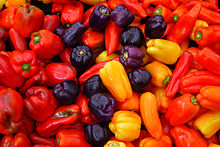- Capsicum annuum
-
Capsicum annuum Capsicum annuum cultivars Scientific classification Kingdom: Plantae (unranked): Eudicots (unranked): Asterids Order: Solanales Family: Solanaceae Genus: Capsicum Species: C. annuum Binomial name Capsicum annuum
L.Varieties Capsicum annuum L. var. grossum
Capsicum annuum var. lycopersiciforme
C. a. var. glabriusculum[1]Capsicum annuum is a domesticated species of the plant genus Capsicum native to southern North America and northern South America.[1][2] The three species C. annuum, C. frutescens and C. chinense all evolved from a single common ancestor located somewhere in the northwest Brazil - Colombia area.[3] This species is the most common and extensively cultivated of the five domesticated capiscums.
Contents
Characteristics
Although the species name annuum means “annual” (from the Latin annus “year”), the plant is not an annual and in the absence of winter frosts can survive several seasons and grow into a large perennial shrub.[3] The single flowers are an off-white (sometimes purplish) color whilst the stem is densely branched and up to 60 centimetres (24 in) tall. When ripe, the fruit may be green, yellow or red. Whilst the species can tolerate most climates, C. annuum is especially productive in warm and dry climates.
Uses
Culinary
The species is a source of popular sweet peppers and hot chilis with numerous varieties cultivated all around the world. In American English the plant is commonly known as a chili pepper or bell pepper.
In British English, the sweet varieties are called red or green peppers[4] and the hot varieties chillies,[5] whereas in Australian and Indian English the name capsicum is commonly used for bell peppers exclusively and chilli is often used to encompass the hotter varieties.
Sweet peppers are very often used as a bulking agent in ready-made meals and take-away food, because they are cheap, have a strong flavour, and are colorful. The colorful aspect of peppers increases the visual appeal of the food, making it more appetizing. Foods containing peppers, especially chili peppers, often have a strong aftertaste this is due to the presence of capsinoids in peppers. Capsaicin, a chemical found in chili peppers, creates a burning sensation once ingested which can last for several hours after ingestion.
Medicinal
Hot peppers are used in medicine as well as food in Africa[6] and other countries.
English botanist John Lindley described C. annuum on page 509 of his 1838 'Flora Medica' thus:
“ It is employed in medicine, in combination with Cinchona in intermittent and lethargic affections, and also in atonic gout, dyspepsia accompanied by flatulence, tympanitis, paralysis etc. Its most valuable application appears however to be in cynanche maligna (acute diphtheria) and scarlatina maligna (malignent Scarlet fever, used either as a gargle or administered internally.) ” In ayurvedic medicine, C. annuum is classified as follows:[7]
- Gunna (properties) – ruksh (dry), laghu (light) and tikshan (sharp)
- Rasa dhatu (taste) – katu (pungent)
- Virya (potency) – ushan (hot)
Ornamental
Some cultivars grown specifically for their aesthetic value include the U.S. National Arboretum's Black Pearl[8] and the Bolivian Rainbow. Ornamental varieties tend to have unusually coloured fruit and foliage with colors such as black and purple being notable. All are edible, and most (like Royal Black) are mild. Ornamental chillies are also generally more susceptible to disease and adverse weather conditions owing to their extravagant nature and genetic modification specifically for appearance.[9]
Gallery
See also
- International Code of Nomenclature for Cultivated Plants
- List of capsicum cultivars
- Capsicum
- Paprika
Notes and references
- ^ a b "Capsicum annuum L.". Germplasm Resources Information Network. United States Department of Agriculture. 1997-01-22. http://www.ars-grin.gov/cgi-bin/npgs/html/taxon.pl?8904. Retrieved 2010-07-29.
- ^ Latham, Elizabeth (2009-02-03). "The colourful world of chillies". Stuff.co.nz. http://www.stuff.co.nz/life-style/food-wine/1756288. Retrieved 2009-03-08.
- ^ a b Katzer, Gernot (May 27, 2008). "Paprika (Capsicum annuum L.)". http://www.uni-graz.at/~katzer/engl/Caps_ann.html. Retrieved February 21, 2011.
- ^ Pepper
- ^ Chilli
- ^ Grubben, G.J.H. & Denton, O.A. (2004) Plant Resources of Tropical Africa 2. Vegetables. PROTA Foundation, Wageningen; Backhuys, Leiden; CTA, Wageningen.
- ^ "Capsicum Annuum". http://www.ayushveda.com/herbs/capsicum-annuum.htm. Retrieved February 21, 2011.
- ^ "Capsicum annuum "Black Pearl"". U.S. National Arboretum. March 2006. http://www.usna.usda.gov/Newintro/BlackPearl_LR.pdf. Retrieved February 21, 2011.
- ^ "Ornamental Pepper Plant Care". House plant care tips. Guide to Houseplants. http://www.guide-to-houseplants.com/ornamental-chili-pepper.html. Retrieved 7 May 2011.
External links
- National Center for Biotechnology Information - Capsicum annuum
- PROTAbase on Capsicum annuum
- Texas A&M University
Capsicum cultivars C. annuum Aleppo · Anaheim · Ancho · Banana pepper · Bell pepper · Cascabel · Cayenne · Chilaca · Chiltepin · Cubanelle · De árbol · Dundicut · Fresno · Guajillo · Hungarian wax · Italian sweet · Jalapeño · Mirasol · Macho · Mulato · New Mexico (Anaheim) · Paprika · Pasilla · Peperoncini · Peter · Piquín · Pimento · Poblano · Puya · Serrano · Shishito · Tien TsinC. chinense Adjuma · Ají Limo · Ají dulce · Datil · Fatalii · Habanero · Hainan Yellow Lantern Chili · Madame Jeanette · Naga Jolokia · Red Savina Habanero · Scotch bonnetC. frutescens C baccatum C. pubescens Categories:- Capsicum
- Plants described in 1753
- Medicinal plants
Wikimedia Foundation. 2010.




